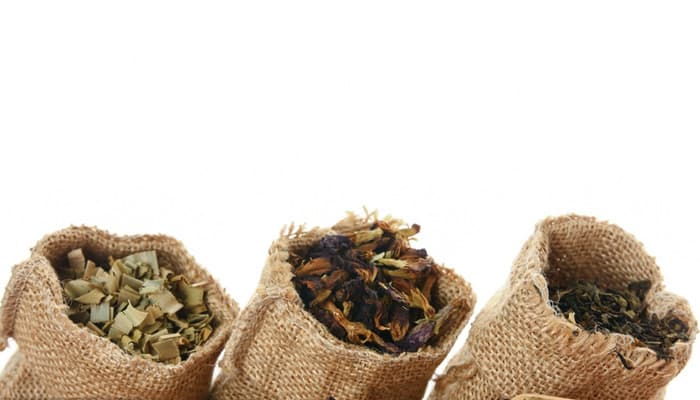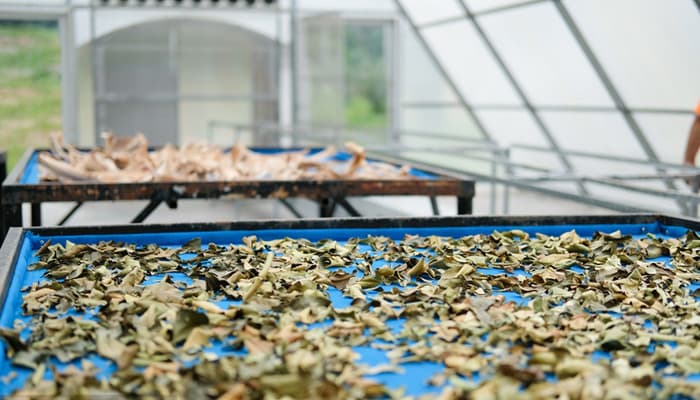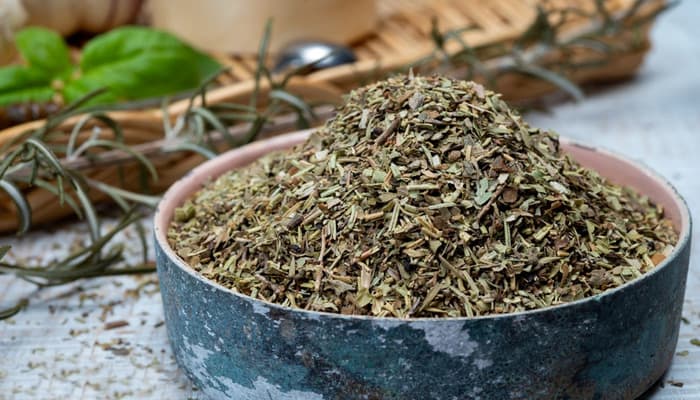Project Overview

- Working Time: 2 – 3 hrs
- Total Time: 2 wks
- Skill Level: Beginner
- Estimated Cost: $10-$15
Herbs from your garden are at their best when used fresh, but there are often more than you can use in one season. That’s when drying herbs becomes useful. Air drying is not only the simplest and most affordable method, but it also helps preserve the essential oils of the herbs, which maintain their flavor.

Before Getting Started

Air drying works best with herbs that have low moisture content, such as bay, dill, angelica, marjoram, oregano, rosemary, summer savory, and thyme. To preserve the best flavor of these herbs, allow them to dry naturally or use a food dehydrator. Avoid using a microwave or an oven set on low, as they can cook the herbs slightly, reducing the oil content and flavor. Use these appliances only if necessary.
For herbs with high moisture content, like basil, chives, mint, and tarragon, consider using a dehydrator, but for better flavor retention, freezing may be a better option. It’s easy and faster than drying.

When to Harvest Your Herbs for Drying

When you’re ready for your final trimming of the season:
- Harvest herbs before they flower to capture the fullest flavor. Even if you’ve been harvesting all season, your plants might not get the chance to flower. However, by late summer, herbs will start to decline as temperatures drop, making this the right time to harvest and dry.
- Cut branches in the midmorning, allowing the morning dew to dry, but before the plants wilt under the afternoon sun.
- Do not cut the entire plant unless you plan to replace it. Never remove more than 1/3 of the plant’s branches at one time or cut back by more than 2/3.
Once dried and stored properly, herbs will maintain good flavor for up to one year.
What You’ll Need

Equipment / Tools:
- Pruners or garden scissors
- Airtight containers
- String or rubber bands
Materials:
- Paper bag
- Container labels
- Paper towels
Instructions
How to Dry Fresh Herbs

Gather Clippings
Collect the clippings you want to dry.

Shake the Branches
Gently shake the branches to remove any insects. As you won’t be washing the herbs thoroughly, make sure to remove as many pests as possible.

Ensure the Herbs Are Dry

If you’ve picked herbs while the plants were dry, simply shake off any soil. If needed, rinse with cool water and gently pat dry with paper towels. Lay or hang the herbs where air circulation is good to help them dry quickly. Wet herbs can mold and rot.

Remove the Lower Leaves

Remove the leaves at the bottom of the stems. You can use these leaves fresh or dry them separately. Also, remove any yellowed or diseased leaves. These have already lost flavor due to seasonal stress.

Bundle the Stems Together

Gather 4 to 6 stems and tie them together using string or a rubber band. The bundles will shrink as they dry, so check periodically to ensure they don’t slip. For high-moisture herbs, use smaller bundles to allow airflow between the stems and prevent rotting.

Optional: Add the Herbs to Paper Bags
Some people find paper bags help dry herbs more quickly and evenly. Punch holes in a paper bag, place the bundles upside down inside, and secure the bag by gathering the top around the bundle. Don’t overcrowd the bag, and label it with the herb’s name.
Hang the Herbs Upside Down
An old method for drying herbs is to simply hang them upside down in a warm, airy room and let nature do the work.
How to Store Herbs
After drying:
Discard Any Moldy Herbs
If any herbs show signs of mold, discard them immediately as the mold will spread.

Store Herbs in Airtight Containers
Store the dried herbs in airtight containers, such as small canning jars or zippered plastic bags. Whole leaves retain more flavor than crushed ones, so consider keeping them whole and crushing them when needed.

Label and Date the Containers
Label and date the containers for easy identification.

Store in a Cool, Dry Spot
Keep the containers in a cool, dry location away from direct sunlight. Amber-colored canning jars work well to block sunlight.

Tips for Using Dried Herbs
Once your herbs are dried and stored:
- To use herbs in cooking, simply pull out a stem and crumble the leaves into the dish. You can easily loosen the leaves by running your hand down the stem.
- Use 1 teaspoon of crumbled dried leaves in place of 1 tablespoon of fresh herbs.
- Dried herbs are best used within a year, as they lose flavor and color over time.
